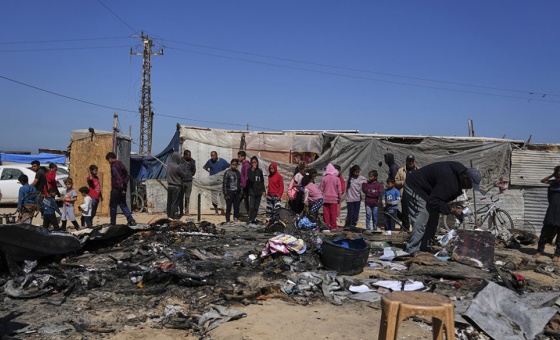This is the last article you can read this month
You can read more article this month
You can read more articles this month
Sorry your limit is up for this month
Reset on:
Please help support the Morning Star by subscribing here
LAST weekend saw an eventful couple of days in the Mediterranean waters off Malta’s southern coast.
Over 140 people in two overcrowded rubber boats were saved by a coalition of civilian refugee rescue organisations within the island nation’s search-and-rescue (SAR) zone.
I initially set out to write up a short report on the weekend’s rescues. But after speaking on Sunday with Eike, an activist who witnessed the events from the skies, I realised that the situation was much more complicated.
In this, part one of two articles examining last weekend’s events, Eike tells us what happened on Friday. We’ll look at Saturday in part two.
He is a tactical co-ordinator for the Seabird, a reconnaissance aircraft operated from the Italian island of Lampedusa by German NGO Sea Watch.
On Friday, its crew spotted a boat carrying 40 people about 60 nautical miles to the south.
“It was deep inside Malta’s SAR zone,” says Eike (pronounced how an American would say the sports brand “Nike” but without the N).
“We contacted the closest merchant vessel to the boat, which was the Vos Triton,” he tells me.
“The contact was positive. The Vos Triton agreed to change course towards the distress case. But when we tried to contact them again, they wouldn’t answer the radio any more and headed back north, away from the distress case.”
We’ll discuss the Vos Triton more in part two tomorrow but, suffice to say now that the ship should not have abandoned its moral and international legal duty to help.
Eike tells me that the Seabird managed to contact another merchant vessel, the Asalet. This ship was really co-operative, he says, and agreed to look out for the distress case but unfortunately couldn’t find the boat.
In the meantime, rescue ship the Open Arms — operated by a Spanish NGO of the same name — was heading towards the boat’s co-ordinates. However, so was someone else.
“We were flying in the vicinity of the distress case when we suddenly saw the so-called Libyan Coastguard arriving in their patrol vessel, Fezzan. It was speeding at full steam, at about 30 knots, towards it,” Eike says.
Many of the activists involved in the civilian refugee rescue effort in the central Mediterranean refer to Libya’s coastguard with the prefix “so-called,” with the whole being abbreviated as scLCG.
They say that the Libyan Coastguard does not abide by the international law of the sea nor by international human rights conventions, and that its only purpose is to conduct what are referred to as “pullbacks” — intercepting refugees and forcibly returning them to the place that they were trying to escape. In legal terms, this is called refoulement.
It is not just the dedicated activists who say the people escaping Libya should not be sent back there. The International Organisation for Migration (IOM), an affiliate to the United Nations, has repeatedly warned that the country is not safe for migrants and that no-one should be returned to it.
The Libyan Coastguard — which is funded, trained and supported by the European Union — intercepted and returned 11,891 people last year and 1,956 people so far in 2021, according to the latest IOM estimates.
“We checked back on the distress case,” Eike continues, “and we realised that the scLCG was heading directly towards one of the Open Arms rhibs.”
Rigid-hulled inflatable boats (rhibs) are boats attached to a ship from which rescuers hand out life jackets, water, food, blankets, etc, to survivors before taking them to their ship.
“When we approached, the scLCG was directly next to a rhib. My impression was that the scLCG was trying to block them.
“The Fezzan then headed towards the other Open Arms rhib, passing really close by to it at high speed.
“The rhib and the Fezzan stopped for a moment next to each other. I don't know if they exchanged communications between each other. I can only say that it looked intimidating.
“I was really glad that we were on scene and to be another witness to this. You never know what can happen in such situations.”
Indeed, in October 2019 and again in April last year, Libyan-flagged vessels fired bullets into the waters around NGO ship the Alan Kurdi as its crew were bringing refugees on board.
Fortunately, the Opens Arms crew eventually managed to bring all 40 people onto the ship, despite whatever it was that the Libyan Coastguard was trying to do.
“It happened last night,” Open Arms tweeted on Saturday morning above a picture of the survivors in life jackets on their crowded boat as a woman held up a baby.
“Rafel and [her] three-month-old baby Moez were rescued together with 38 more people in a flimsy boat on the high seas.
“It took many hours of search and encounters with a Libyan patrol boat, but it was worth it. Every life counts.”
All of this, don’t forget, was taking place within Malta’s SAR zone. Its maritime authorities should have been in charge of co-ordinating the rescue, not activists. Its coastguard should have been out there, certainly not the Libyan Coastguard.
In response to the so-called “refugee crisis” in 2015, the EU launched a naval mission, which eventually became known as Operation Sophia, to disrupt the human-trafficking networks off the Libyan coast. It saved tens of thousands of lives.
In 2019, however, the EU pulled its ships from the central Mediterranean, pumped more money to the Libyan Coastguard and left only European Border and Coastguard Agency (Frontex) planes to monitor migrant departures from Libya.
Refugee rights organisations in the central Mediterranean, as well as in the Aegean Sea, at the Greek-Turkish-Bulgarian borders and elsewhere, have repeatedly accused Frontex of either aiding or carrying out refugee pushbacks and pullbacks on the external frontiers of the EU.
Frontex denies the allegations and told the Star last week that its officers are bound by a code of conduct that “includes a paragraph specifically related to the prevention of refoulement and the upholding of human rights.”
The agency said that an internal inquiry into recent allegations “concluded that there was no evidence of a direct or indirect participation of Frontex staff or officers deployed in Frontex operations in alleged ‘pushbacks’ in the Aegean Sea.”
Eike tells me that Frontex’s Eagle 1 aircraft was also on the scene last Friday.
“We don’t know if there was any communication between the scLCG and the Eagle 1,” he says. “But what it really shows is that there is no hesitation to facilitate illegal pushbacks deep inside a European SAR.
“We out there for around seven hours. It was a crazy day.
“While we were heading back, we heard that the Open Arms had reached the distress case. As you can imagine, it was a real relief.”
 Ben Cowles
Ben Cowles






